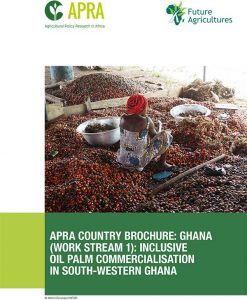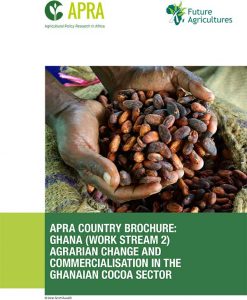The output of the work and research conducted in Ghana under APRA is shared below. You can also download it in PDF form with direct links to related papers and publications.
RESEARCH
Contact Person: Fred Dzanku | fdzanku@gmail.com
Inclusive oil palm commercialisation in south-west Ghana
APRA is conducting quantitative and qualitative research to examine the impacts of oil palm commercialisation models on household welfare in the Ahanta West and Mpohor districts in south-western Ghana.
-
Research objective
This study aims to describe existing OPC models in the districts of Ahanta West and Mpohor. It will seek to discover who participates in the OPC models identified and why, and examine how participation in different models effects welfare. Of particular interest is whether the study’s two focuses – participation and welfare – exhibit a gendered component and, if so, why.
-
Study questions
• Which farmers engage with which OPC arrangements, and why?
• What poverty implications arise from participating in different OPC arrangements, and how do these outcomes differ across groups?
• What is the relationship (synergies or competition) between different OPC arrangements and resource allocations to other crops?
• Do different OPC arrangements have varying
-
Findings
• Using multiple welfare indicators, we find that observed OPC pathways yield differential welfares.
• Considering the objective measures of welfare such as income and consumption, farmers in the ‘ownprocessing commercialisation’ pathway represent the best outcome for increasing household welfare.
• Based on per capita income and non-land asset measures of welfare, farmers who sell to local market traders are worse-off financially.
• Based on subjective measures of welfare such as perception about one’s life circumstances, those who sell through agents are poorer because they believe they are being cheated by this marketing arrangement.
• High return participation is enhanced by: the presence of females; having land holdings; increased production rates; the availability of working capital; access to paved roads; good proximity to an oil palm processing company; the availability of agro-services; and the availability of a processing mill within the community.
• Formal contractual arrangements have stopped as a result of dissatisfaction regarding contract terms and a general breakdown of trust between the market participants. This is particularly the case among those using the services of agents, and this appears to be partly fuelling farmers’ interest in their own oil palm processing.
-
Conclusion and policy messages
The results of the APRA-Ghana Work Stream 1 studies clearly show that smallholder farmers are very responsive to market incentives and are willing to commit resources (land, labour and capital) to expanding their commercial agriculture enterprises as shown by their high levels of specialisation in non-food cash crop production. Yet, the rewards to such commercialisation endeavours are not equitably distributed across gender and generation, and are constrained by structural and institutional factors including marketing rigidities (limited ability to participate in better remunerating markets), poor land tenure arrangements, and poor hard and soft infrastructure (unavailability of associations and poor roads). The following policy options can help address some of these challenges and help promote pro-poor commercialisation
- Put greater focus on household- and community level agro-processing. Given that Ghana is a net importer of oil palm and that own-processing offers options to significantly increase welfare, interventions such as credit facilities – which allow communities to purchase locally-made processing machines – could be a game-changer.
- Develop community-based mechanisation through public-private partnerships (PPPs). As the presence of a processing facility within the community is the strongest predictor of own-processing, a PPP arrangement providing an incentive for modern, community-based, mechanised processing facilities could boost processing rates and potentially enhance household welfare.
- Develop rural infrastructure (particularly roads), as this could allow for better opportunities and more cost efficiency among those who prefer to deal with oil palm companies directly.
- Form strong oil palm-based farmer associations (which we found to be missing in the study areas), as this could help lower the unit costs required for engaging directly with companies. Providing cooperative management training to such groups will further enhance their performance and sustainability.
Agrarian change and commercialisation of in the Ghanaian cocoa sector
Comparing Ghana’s Eastern and Western regions, this study aims to explore the historical pathways and dynamics of change in cocoa production, with reference to patterns of migration, accumulation, and dispossession. We will examine the different livelihood trajectories in relation to changes in cropping systems with regards to land, labour, natural resources, social relations, and outcomes for rural women and men.;
-
Research objective
Comparing Ghana’s Eastern and Western regions, this study aims to explore the historical pathways and dynamics of change in cocoa production, with reference to patterns of migration, accumulation, and dispossession. We will examine the different livelihood trajectories in relation to changes in cropping systems with regards to land, labour, natural resources, social relations, and outcomes for rural women and men.
-
Study questions
• How do development patterns in cocoa production differ across space and time in Ghana, and what accounts for these differences?
• What are the class and gender characteristics and profiles of cocoa farmers and how have these changed over time?
• What happens to initial investment and capital accumulation in cocoa? Does capital spread geographically, across sectors, or out of the agriculture sector altogether? Or does it decline and dissipate?
• How does the decline of forest land affect the cocoa sector and investments in cocoa? Is there a movement towards greater intensification on smaller land areas?
• What impact does cocoa cultivation have on food crop cultivation, and on relations between those who cultivate food crops and cocoa (and/or other cash crops) in the same household?
• What impacts do the global cycles of boom and recession, and the opening of new areas for cocoa cultivation, have on cocoa production in Ghana?
• What political-economic factors have shaped the emergence, spread, and persistence of cocoa production in Ghana?
-
Findings
1. What is happening in cocoa farming?
- As forest conditions decline, the general trend in cocoa is seeing a move towards smaller, intensive farms (who’ve higher expenditure per hectare on labour and inputs, which absorbs a large percentage of profits).
- The distinct strategies of cocoa cultivation vary, from high-input commercial farms to low-input social security for old age. Among the latter, the plantation is envisaged as capital that can be transacted under a sharecrop arrangement with a tenant to provide an income for old farmers who are not strong enough to engage in strenuous manual labour.
- Cocoa is still considered an important crop, due to a lack of more promising alternatives for small areas of land.
- Adoption of hybrid varieties and inputs are not correlated with yields:
– Investments in labour are critical.
– The costs of inputs are high.
– Extension messages are not clearly understood by farmers.
2. What effects have resulted from these?
- Rates of impoverishment among farmers is increasing as farm productivity decreases due to diseases and falling real cocoa prices.
- Yields are low, and most farmers struggle to follow extension recommendations due to cost requirements.
- Sharecropping is being utilised as a strategy to deal with high production costs, which, in turn, causes land fragmentation and issues regarding economies of scale.
- There is increasing social differentiation among farmers, which is determined by the size of farms, the use of hybrid seeds, fertilisers, and agrochemicals, and yield outputs per hectare.
- Large proportions of families are moving out of cocoa and away from agriculture altogether, including high numbers of women – as land becomes scarcer and incomes from agriculture decline.
-
Conclusion and policy messages
Conclusion
The future of cocoa in Ghana relies heavily on intensification and agroforestry groves, as these will enable increases in productivity, a reduction in disease burdens, greater availability of food from crops and other economic trees, and diversification into other livelihood activities. Enhanced provision of credit facilities to both relatively large and small farmers is also required, along with continuous research into approaches to increase production – not only via the use of more chemicals, but also by encouraging agroecological farming techniques.Policy recommendations
• Create cocoa production systems that minimise the use of costly agro-chemicals and better reflect the circumstances and capacities of farmers, including women and poorer farmers.
• Use climate change and ReDD+ initiatives to create opportunities for COCOBOD (Ghana Cocoa Board) and other state-led research institutions to create more diverse, eco-friendly cocoa agroforests that integrate cocoa with other income-generating forest products as an alternative to high input cocoa systems.
• Support and respect locally-evolved workable land tenure and labour practices to ensure access for women and young farmers.
• Increase access to financial capital for all categories of farmers while avoiding exploitative rents and political interferences.



